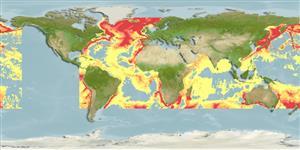Actinopterygii (ray-finned fishes) >
Anguilliformes (Eels and morays) >
Synaphobranchidae (Cutthroat eels) > Synaphobranchinae
Etymology: Synaphobranchus: Greek, syn, symphysis = grown together + Greek, aphoo, aphiemi = to throw + Greek, brangchia = gill (Ref. 45335).
Environment / Climate / Range
Ecology
Marine; bathydemersal; depth range 120 - 4800 m (Ref. 50610), usually 400 - 2200 m (Ref. 58302). Deep-water; -1°C - 10°C (Ref. 26895), preferred ?; 69°N - 40°S, 85°W - 154°W
Eastern Atlantic: Faroes and Iceland to Cape Verde, Nigeria, Namibia (Ref. 27121), and South Africa. Western Atlantic: Greenland to Bahamas; also Brazil. Northwest Atlantic: Canada (Ref. 5951). Indo-West Pacific: Japan and Australia (Ref. 7300); absent in the Eastern Pacific except in Hawaii and the Indian Ocean.
Size / Weight / Age
Maturity: Lm ? range ? - ? cm
Max length : 100.0 cm TL male/unsexed; (Ref. 27000)
Short description
Morphology | Morphometrics
Found on the continental slope near the upper limit of abyssal zone (Ref. 6726). Epibenthic (Ref. 58426). Probably most common in 800 to 2,000 m (Ref. 5235). Do not tolerate higher water temperatures (Ref. 5951). Feeds mainly on Decapoda, Natantia, amphipods, but also fishes and cephalopods (Ref. 6726). Caught by bottom longline and baited fish trap (Ref. 85806).
Life cycle and mating behavior
Maturity | Reproduction | Spawning | Eggs | Fecundity | Larvae
Sulak, K.J. and Y.N. Shcherbachev, 1997. Zoogeography and systematics of six deep-living genera of synaphobranchid eels, with a key to taxa and description of two new species of Ilyophis. Bull. Mar. Sci. 60(3):1158-1194. (Ref. 26895)
IUCN Red List Status (Ref. 115185)
CITES (Ref. 94142)
Not Evaluated
Threat to humans
Harmless
Human uses
Fisheries: of no interest
Tools
Special reports
Download XML
Internet sources
